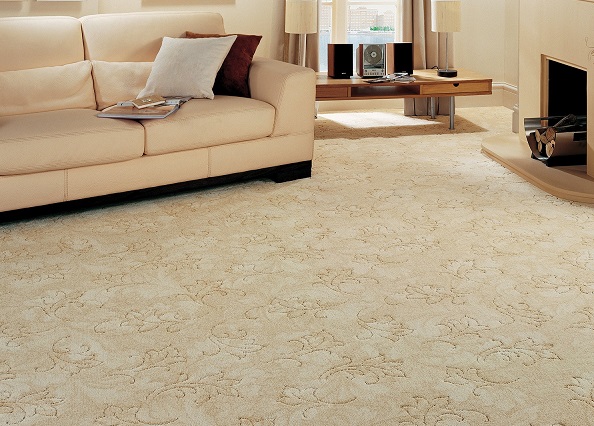Types of carpet
Contents |
[edit] Introduction
Carpet is a type of flooring made of an upper layer of pile attached to a backing. The pile is usually wool or fibers such as nylon, polyester or polypropylene that are heat-treated after having been twisted together into tufts or woven. There are many varieties of texture, style and colour available and generally carpet is both durable and easy to maintain. Carpet also has insulating properties in terms of both heat and sound. However, carpets can stain quite easily and can be damaged by water and damp.
As there is no universal grading for carpet quality, the weight and density should be assessed instead. The weight indicates the quantity of fibers that the carpet holds; the more fibres, the heavier the weight, and the higher quality of the carpet. The density indicates how many fibers are in the pile and how closely packed they are; the denser the pile, the higher quality.
For more information, see How to fit carpet.
[edit] Fibers
The different types of fibers that are used for carpets include:
- Nylon: The most popular type of fiber, it is soft, durable and resistant to abrasion.
- Olefin: Also known as polypropylene, this fiber is tougher than nylon but is resistant to moisture and mould, which makes it suitable for basements.
- Wool: A natural fiber which produces an eco-friendly floor covering, it is durable and stain-resistant.
- Acrylic: Not widely used but can serve as an inexpensive alternative to wool.
- Polyester: An eco-friendly fiber and can hold colours without them fading over time, although it is prone to flattening, making it unsuitable for high-traffic applications.
[edit] Carpet construction
The way the fibres are attached to their backing is what defines the two main types of carpet construction.
[edit] Loop pile
This is where the fibers are bent over into small loops, creating a durable and stain-resistant carpet. However, its low profile provides only limited cushioning. The different types include:
[edit] Level loop
Also known as Berber, this leaves the entire loop intact on the surface of carpet. They are suitable for areas of high traffic, although tend to be less padded and comfortable.
[edit] Multi-level loop
The carpet has a patterned texture as a result of the loops being at varying heights.
[edit] Cut pile
This is where the fibers are cut rather than being looped, creating a denser and softer carpet than loop pile. They are also easier to clean. Changing the shearing angle that cuts the fiber loop or using different treatments before and after inserting the thread into the backing, can achieve different styles. As the threads are more rigid they tend to be less durable than loop pile carpets. The different types include:
[edit] Plush
Also known as ‘velvet cut pile’, this is characterised by its smooth and formal appearance, achieved by fibers that are short and densely-packed. Only tends to be used in formal, low-traffic applications.
[edit] Saxony
This has a smooth finish and the longer, twisted fibers provide a softer and fuller body, although this means that indents can be caused by furniture, footprints, and so on.
[edit] Textured
This has a rougher surface texture created by fibers of uneven lengths.
[edit] Frieze
Also known as ‘shag carpet’, it consists of long fibers that are tightly twisted and curled. It is a durable type of carpet and is suitable for high-traffic applications.
[edit] Cable
This is a particularly comfortable type of carpet due to having long, thick fibers.
[edit] Find out more
[edit] Related articles on Designing Buildings Wiki
Featured articles and news
The UK's Modern Industrial Strategy: A 10 year plan
Previous consultation criticism, current key elements and general support with some persisting reservations.
Building Safety Regulator reforms
New roles, new staff and a new fast track service pave the way for a single construction regulator.
Architectural Technologist CPDs and Communications
CIAT CPD… and how you can do it!
Cooling centres and cool spaces
Managing extreme heat in cities by directing the public to places for heat stress relief and water sources.
Winter gardens: A brief history and warm variations
Extending the season with glass in different forms and terms.
Restoring Great Yarmouth's Winter Gardens
Transforming one of the least sustainable constructions imaginable.
Construction Skills Mission Board launch sector drive
Newly formed government and industry collaboration set strategy for recruiting an additional 100,000 construction workers a year.
New Architects Code comes into effect in September 2025
ARB Architects Code of Conduct and Practice available with ongoing consultation regarding guidance.
Welsh Skills Body (Medr) launches ambitious plan
The new skills body brings together funding and regulation of tertiary education and research for the devolved nation.
Paul Gandy FCIOB announced as next CIOB President
Former Tilbury Douglas CEO takes helm.
UK Infrastructure: A 10 Year Strategy. In brief with reactions
With the National Infrastructure and Service Transformation Authority (NISTA).
Ebenezer Howard: inventor of the garden city. Book review.
The Grenfell Tower fire, eight years on
A time to pause and reflect as Dubai tower block fire reported just before anniversary.
Airtightness Topic Guide BSRIA TG 27/2025
Explaining the basics of airtightness, what it is, why it's important, when it's required and how it's carried out.
Construction contract awards hit lowest point of 2025
Plummeting for second consecutive month, intensifying concerns for housing and infrastructure goals.
Understanding Mental Health in the Built Environment 2025
Examining the state of mental health in construction, shedding light on levels of stress, anxiety and depression.






















